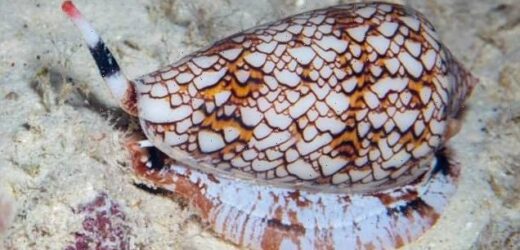Deadly VENOM from poisonous sea snails could hold the key to developing new painkillers, study claims
- Cone snails are some of the deadliest creatures to roam the oceans
- They extend a long flexible tube before firing a venomous tooth at their victim
- Modified versions of venom could be used to block pain receptors in humans
- It could offer a more effective and less addictive way to kill pain
While cone snails are stunning animals with beautifully adorned shells, they’re also some of the deadliest creatures to roam the oceans.
Now, scientists from the University of Glasgow have revealed plans to harness their venom to develop new painkillers that are more effective and less addictive than current options.
Dr Andrew Jamieson, who is leading the project, said: ‘The cone snail might seem like an unlikely prospect for breakthroughs in drug discovery, but the conotoxins it produces have a lot of intriguing properties which have already shown promise in medicine.’
While cone snails are stunning animals with beautifully adorned shells, they’re also some of the deadliest creatures to roam the oceans
What are cone snails?
Cone snails are marine gastropods characterized by a conical shell and beautiful color patterns.
Cone snails possess a harpoonlike tooth capable of injecting a potent neurotoxin that can be dangerous to humans.
There are about 600 species of cone snails, all of which are poisonous.
Cone snails live in shallow reefs partially buried under sandy sediment, rocks or coral in tropical and subtropical waters.
Some species have adapted to colder waters.
Source: Divers Alert Network
Cone snails are predatory marine animals found in warm seas and oceans around the world.
They administer stings by extending a long flexible tube called a proboscis, before firing a venomous, harpoonlike tooth at their victim.
Their venom contains chemicals called conotoxins – highly potent neurotoxic peptides, which cause paralysis by blocking parts of the nervous system.
While this can prove fatal for anyone standing in the cone snail’s way, researchers believe that modified versions of their peptides could be used to safely block pain receptors in humans.
The University of Glasgow group is teaming up with machine learning and artificial intelligence experts from the University of Southampton to research how the cone snail’s venom affects human muscles.
Firstly, the team will investigate how conotoxin peptides are structured at a molecular level.
They will then build on that knowledge to synthesise new peptides which show promise for interacting with a particular type of receptors in the human nervous system known as nicotinic acetylcholine receptors, ornAChRs.
Finally, the team will run simulations to determine how effective the synthesised peptides are at binding with muscle receptors.
Dr Jamieson said: ‘This project brings together some of the UK’s leading researchers across a wide range of disciplines to learn about how conotoxins work.
‘Then we’ll look at ways we can engineer new analogues to investigate how effective they might be as novel drugs for a range of medical applications.
‘Those new molecules’ ability to interact with nicotinic acetylcholine receptors could lead to new forms muscle relaxants for anaesthesia, or painkillers which are just as effective as opioids but don’t have the same associated potential for addiction.
Scientists from the University of Glasgow have revealed plans to harness their venom to develop new painkillers that are more effective and less addictive than current options
‘It’s an exciting project and we’re looking forward to getting started.’
While humans are rarely seriously injured by cone snails, as it stands, there is currently no anti-toxin available.
This means that serious stings cannot be effectively treated.
The reserachers hope that their project could also help lead to the development of the first-ever treatments for conotoxin poisoning in the future
Source: Read Full Article




